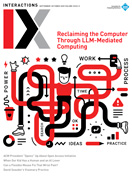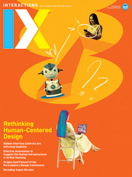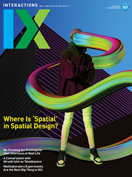Authors:
Elizabeth F. Churchill, Mikael Wiberg
Welcome to the May–June issue of Interactions.
Recently, the idea of spatial computing has seen a thoughtful revision in many texts, including Spatial Computing: An AI-Driven Business Revolution, by Cathy Hackl and Irena Cronin. While digital technologies are good for bridging distances, they can also work in the production of space. In this issue's cover story, Davide Zhang addresses interface design issues, asking "where is 'spatial' in spatial design?" He offers a number of provocative "conflicts"—juxtapositions for us to consider—which he illustrates through sketches and imagery. He presents the conflicts of immersion and attention as examples. Zhang also introduces concepts such as "dynamic ensemble," which create interfaces with an "elastic quality" and "ambient continuity." Using these, he leaves us with ideas for exploring different ways of engaging the spatial in 2D, 2.5D, and 3D digital and physical space design.
Deepfakes are manipulated images, videos, and audio recordings that replace one person's likeness with another using artificial intelligence. Many are shockingly compelling. One of the first broadly shared public discussions about the issue appeared on Reddit in late 2017, addressing a set of deepfakes that face-swapped celebrities into existing pornographic videos. From the creation of nonconsensual explicit content to political manipulation and the spread of misinformation, we have seen evidence of the malicious use of deepfakes. Detecting deepfakes has become increasingly important as their potential for personal and societal harm continues to grow. In their article, John Twomey, Cian O'Mahony, Conor Linehan, and Gillian Murphy focus on designing interventions that challenge conspiracy theories rooted in deepfake misinformation. By illustrating how deepfake technologies are used to discredit accurate, fact-based information, we are invited to reflect on how design can counteract these effects.
Despite AI's promise of eternal digital life, physical life remains ephemeral. In her column, Jie Li explores the interplay between absence and presence, loss and mourning, in her conversation with the visionary HCI researcher Hiroshi Ishii. By centering design in the wake of absence, they explore how Ishii's concept of TeleAbsence challenges our understanding of memory and reimagines the role of technology in amplifying humanity.
Inspired by the RepliCHI initiative, which launched as a response to concerns about reproducibility in HCI, Jonas Oppenlaender argues in our Blog@IX section that multilaboratory experiments can push the boundaries of the field. He states that such multisite experiments would create "opportunities to test theories and systems in varied settings, which would be difficult for any single lab to replicate alone." He notes that multilab experiments are common in fields that have historically led the way in scientific rigor. Of course, a shift to such a model would require new funding models, an expansion of open data initiatives, and the development of shared frameworks and procedures. Only with these in place would labs worldwide be able to collaborate effectively on a large scale and conduct cross-context studies. Oppenlaender offers a compelling argument for investing in the expansion of our collaborative networks.
In one of Interactions' newest sections, Waves, Victor Cheung shares his love of science fiction, demonstrating how he inspired his students to explore new ways of evaluating and reinventing technologies. Over the course of a semester, undergraduate students were invited to use tools, including 3D printing and Arduino with sensors, to re-create a science fiction UI in "real" life. Cheung introduces us to an example of a completed project, accompanied by illustrations.
In Voices, HCI superstar and SIGCHI volunteer Regan Mandryk talks about why she has been such a dedicated volunteer in the SIGCHI community. She recently started the Salish Sea SIGCHI Chapter, bringing together researchers from the west coast of Canada. As she says, the chapter offers a place for people working across the board in areas related to "understanding humans, computers, and their interaction." More personally, she hopes that HCI and UX scholars and professionals can be "driven by values other than productivity."
As always, we leave you with Exit. In this issue, curators Scott Minneman and Renato Verdugo invite us to step into the future with WhatIFpedia, which "generates foresight provocations for the year 2035 in the form of real-looking Wikipedia pages."
As we close out this Welcome, we invite you to contribute to any section in Interactions. We look forward to working with you!
Elizabeth F. Churchill and Mikael Wiberg
[email protected]
Copyright 2025 held by owners/authors
The Digital Library is published by the Association for Computing Machinery. Copyright © 2025 ACM, Inc.







Post Comment
No Comments Found